2018 RENAULT MASTER ignition
[x] Cancel search: ignitionPage 8 of 290

1.2
KEY, RADIO FREQUENCY REMOTE CONTROL: general information (1/3)
Radio frequency remote
control B
1 Locking all the opening elements.
2 Unlocking all the opening elements.
3 Key for ignition switch, doors and
fuel filler cap.
4 Locking/unlocking the luggage com- partment and, depending on the ve-
hicle, the sliding side doors.
Radio frequency remote
control A
1 Locking all the opening elements.
2 Unlocking all the opening elements.
3 Key for ignition switch, doors and
fuel filler cap.
1
2
3
The key must not be used for any
function other than those described
in the handbook (removing the cap
from a bottle, etc.).Advice
Avoid leaving the remote control in
hot, cold or humid areas.
A
1
2
3
4
B
Driver’s responsibility
when parking or stopping
the vehicle
Never leave an animal,
child or adult who is not self-suffi-
cient alone on your vehicle, even for
a short time.
They may pose a risk to themselves
or to others by starting the engine,
activating equipment such as the
electric windows or locking the
doors.
Also, in hot and/or sunny weather,
please remember that the tempera-
ture inside the passenger compart-
ment increases very quickly.
RISK OF DEATH OR SERIOUS
INJURY.
Page 9 of 290
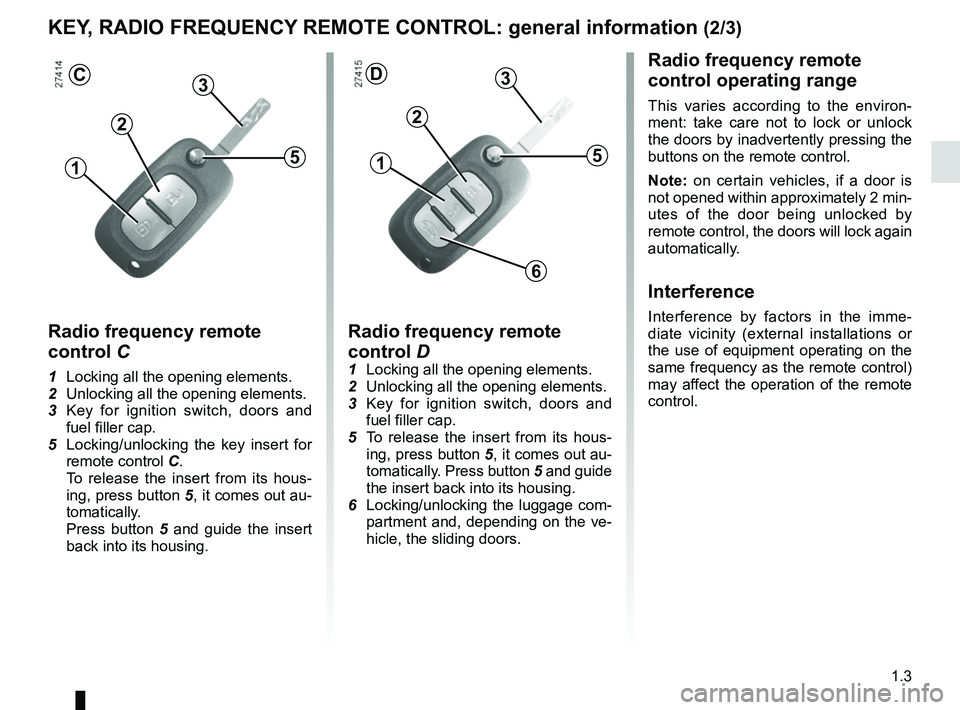
1.3
Radio frequency remote
control operating range
This varies according to the environ-
ment: take care not to lock or unlock
the doors by inadvertently pressing the
buttons on the remote control.
Note: on certain vehicles, if a door is
not opened within approximately 2 min-
utes of the door being unlocked by
remote control, the doors will lock again
automatically.
Interference
Interference by factors in the imme-
diate vicinity (external installations or
the use of equipment operating on the
same frequency as the remote control)
may affect the operation of the remote
control.
KEY, RADIO FREQUENCY REMOTE CONTROL: general information (2/3)
Radio frequency remote
control D
1 Locking all the opening elements.
2 Unlocking all the opening elements.
3 Key for ignition switch, doors and
fuel filler cap.
5 To release the insert from its hous- ing, press button 5, it comes out au-
tomatically. Press button 5 and guide
the insert back into its housing.
6 Locking/unlocking the luggage com- partment and, depending on the ve-
hicle, the sliding doors.
D
1
2
3
5
6
Radio frequency remote
control C
1 Locking all the opening elements.
2 Unlocking all the opening elements.
3 Key for ignition switch, doors and
fuel filler cap.
5 Locking/unlocking the key insert for remote control C.
To release the insert from its hous- ing, press button 5, it comes out au-
tomatically.
Press button 5 and guide the insert
back into its housing.
1
2
C
5
3
Page 16 of 290
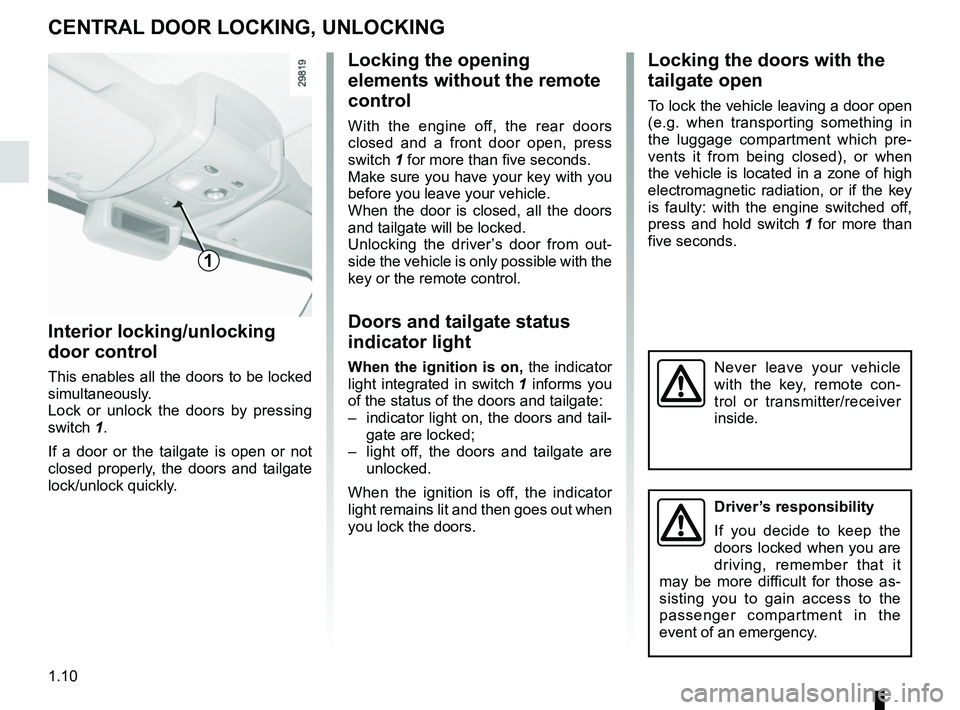
1.10
Locking the doors with the
tailgate open
To lock the vehicle leaving a door open
(e.g. when transporting something in
the luggage compartment which pre-
vents it from being closed), or when
the vehicle is located in a zone of high
electromagnetic radiation, or if the key
is faulty: with the engine switched off,
press and hold switch 1 for more than
five seconds.
Locking the opening
elements without the remote
control
With the engine off, the rear doors
closed and a front door open, press
switch 1 for more than five seconds.
Make sure you have your key with you
before you leave your vehicle.
When the door is closed, all the doors
and tailgate will be locked.
Unlocking the driver’s door from out-
side the vehicle is only possible with the
key or the remote control.
Doors and tailgate status
indicator light
When the ignition is on, the indicator
light integrated in switch 1 informs you
of the status of the doors and tailgate:
– indicator light on, the doors and tail- gate are locked;
– light off, the doors and tailgate are unlocked.
When the ignition is off, the indicator
light remains lit and then goes out when
you lock the doors.
Interior locking/unlocking
door control
This enables all the doors to be locked
simultaneously.
Lock or unlock the doors by pressing
switch 1.
If a door or the tailgate is open or not
closed properly, the doors and tailgate
lock/unlock quickly.
CENTRAL DOOR LOCKING, UNLOCKING
Never leave your vehicle
with the key, remote con-
trol or transmitter/receiver
inside.
1
Driver’s responsibility
If you decide to keep the
doors locked when you are
driving, remember that it
may be more difficult for those as-
sisting you to gain access to the
passenger compartment in the
event of an emergency.
Page 18 of 290

1.12
RAID (AUTOMATIC LOCKING WHEN DRIVING)
You can decide whether you want to
activate this function.
To activate
With the ignition on, press switch 1
for approximately 5 seconds until you
hear a beep.
The indicator light built into the switch
comes on when the doors are locked.
To deactivate
With the ignition on , press and hold
switch 1 for approximately 5 seconds,
until you hear a beep. The indicator
light in the switch goes out.
Operating principle
When the engine is started, the system
automatically locks the doors when the
vehicle reaches a speed of approxi-
mately 4 mph (7 km/h).
Operating faults
If you notice an operating fault (auto-
matic locking impossible), first check
that all doors are correctly locked. If
they are correctly locked and the fault
is still present, contact an approved
Dealer.
Also make sure that locking has not
been inadvertently deactivated.
If it has, switch the ignition off and on
again and reactivate it.
1
Driver’s responsibility
If you decide to keep the
doors locked when you are
driving, remember that it
may be more difficult for those as-
sisting you to gain access to the
passenger compartment in the
event of an emergency.
Page 20 of 290

1.14
FRONT DOORS (2/2)
Manual locking
With the door closed, lock the door by
pressing button 4.
Lights-on reminder buzzer
If you have switched off the ignition
and left the lights switched on, a re-
minder buzzer will sound when a door
is opened.
NOTE
The front door mechanism cannot
be locked if the door is open.Driver’s responsibility
when parking or stopping
the vehicle
Never leave an animal,
child or adult who is not self-suffi-
cient alone on your vehicle, even for
a short time.
They may pose a risk to themselves
or to others by starting the engine,
activating equipment such as the
electric windows or by locking the
doors.
Also, in hot and/or sunny weather,
please remember that the tempera-
ture inside the passenger compart-
ment increases very quickly.
RISK OF DEATH OR SERIOUS
INJURY.
Page 27 of 290
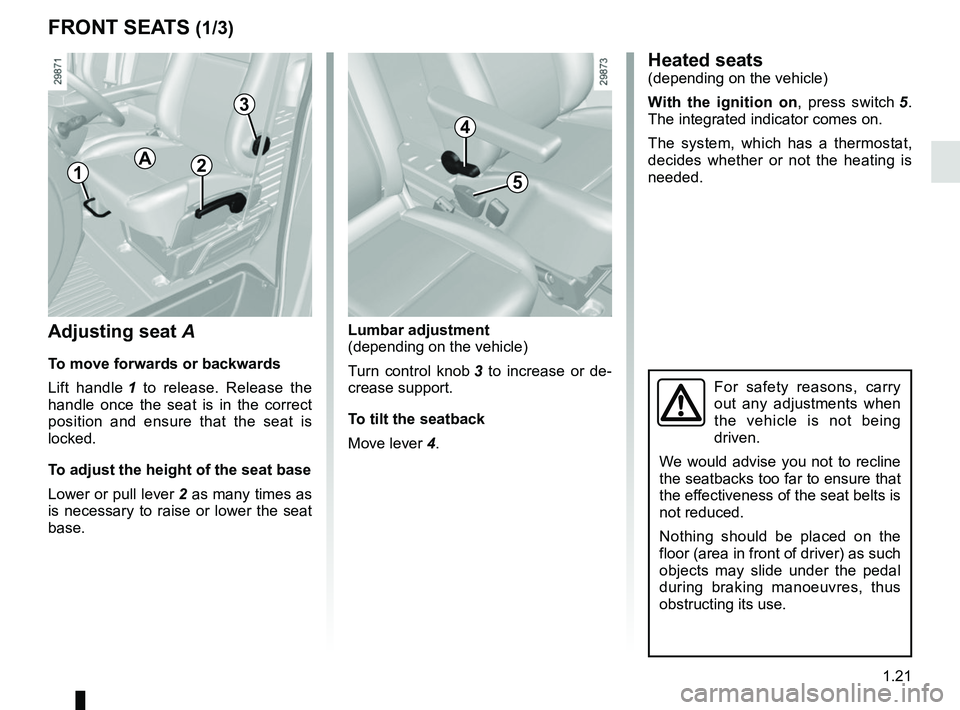
1.21
Lumbar adjustment
(depending on the vehicle)
Turn control knob 3 to increase or de-
crease support.
To tilt the seatback
Move lever 4.
FRONT SEATS (1/3)
Adjusting seat A
To move forwards or backwards
Lift handle 1 to release. Release the
handle once the seat is in the correct
position and ensure that the seat is
locked.
To adjust the height of the seat base
Lower or pull lever 2 as many times as
is necessary to raise or lower the seat
base.
12
3
4
For safety reasons, carry
out any adjustments when
the vehicle is not being
driven.
We would advise you not to recline
the seatbacks too far to ensure that
the effectiveness of the seat belts is
not reduced.
Nothing should be placed on the
floor (area in front of driver) as such
objects may slide under the pedal
during braking manoeuvres, thus
obstructing its use.
Heated seats(depending on the vehicle)
With the ignition on , press switch 5.
The integrated indicator comes on.
The system, which has a thermostat,
decides whether or not the heating is
needed.
5
A
Page 28 of 290
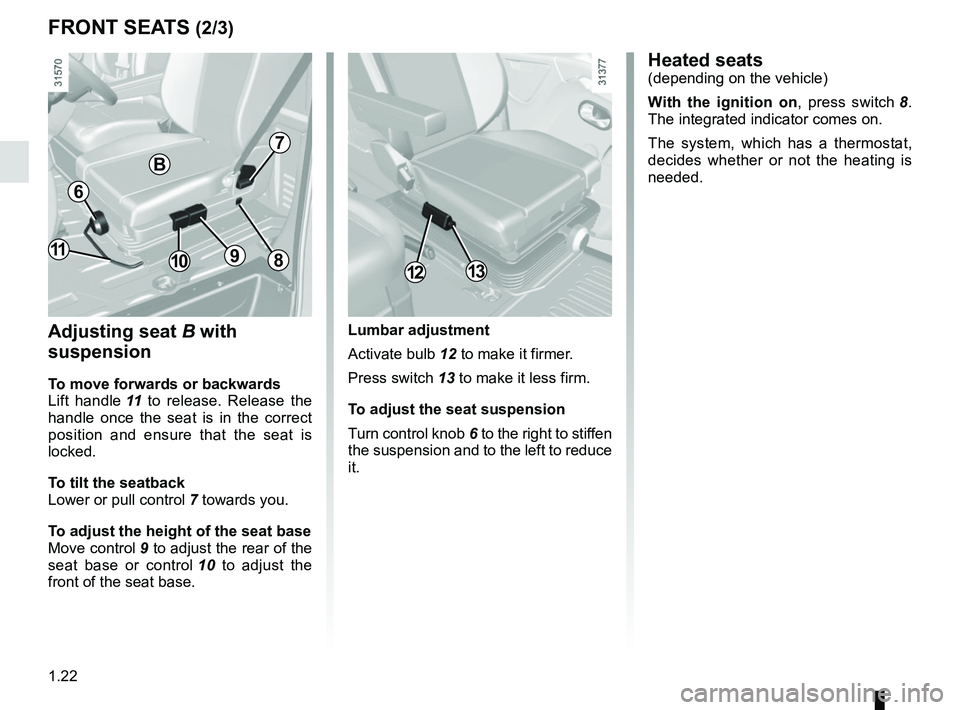
1.22
FRONT SEATS (2/3)
Adjusting seat B with
suspension
To move forwards or backwards
Lift handle 11 to release. Release the
handle once the seat is in the correct
position and ensure that the seat is
locked.
To tilt the seatback
Lower or pull control 7 towards you.
To adjust the height of the seat base
Move control 9 to adjust the rear of the
seat base or control 10 to adjust the
front of the seat base.
6
7
910118
Lumbar adjustment
Activate bulb 12 to make it firmer.
Press switch 13 to make it less firm.
To adjust the seat suspension
Turn control knob 6 to the right to stiffen
the suspension and to the left to reduce
it.
1312
Heated seats(depending on the vehicle)
With the ignition on , press switch 8.
The integrated indicator comes on.
The system, which has a thermostat,
decides whether or not the heating is
needed.
B
Page 34 of 290
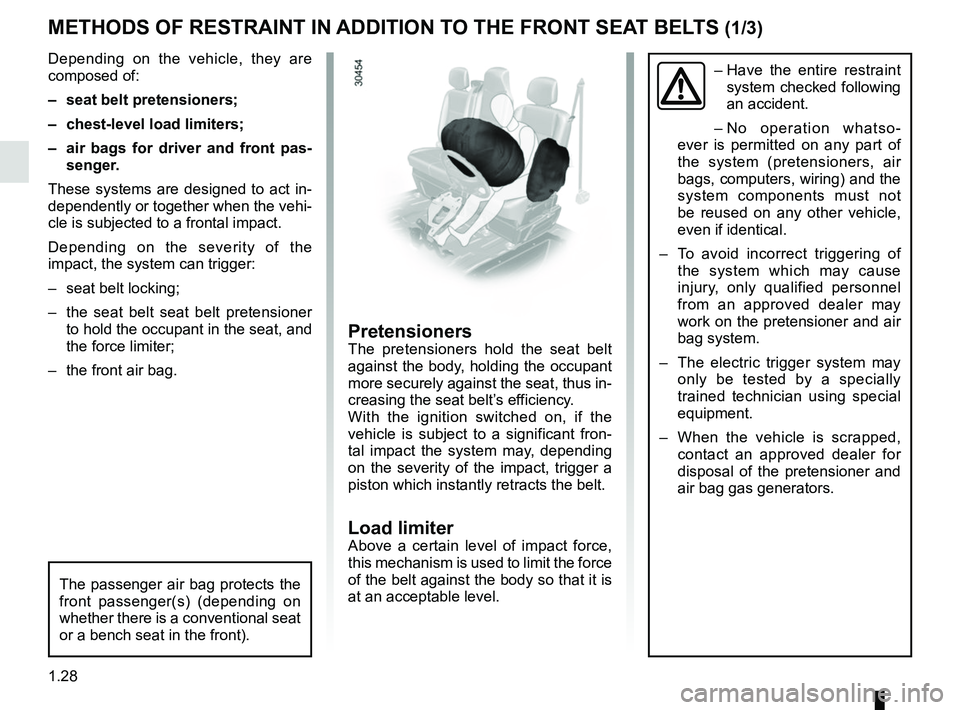
1.28
METHODS OF RESTRAINT IN ADDITION TO THE FRONT SEAT BELTS (1/3)
Depending on the vehicle, they are
composed of:
– seat belt pretensioners;
– chest-level load limiters;
– air bags for driver and front pas-senger.
These systems are designed to act in-
dependently or together when the vehi-
cle is subjected to a frontal impact.
Depending on the severity of the
impact, the system can trigger:
– seat belt locking;
– the seat belt seat belt pretensioner to hold the occupant in the seat, and
the force limiter;
– the front air bag.– Have the entire restraint
system checked following
an accident.
– No operation whatso-
ever is permitted on any part of
the system (pretensioners, air
bags, computers, wiring) and the
system components must not
be reused on any other vehicle,
even if identical.
– To avoid incorrect triggering of the system which may cause
injury, only qualified personnel
from an approved dealer may
work on the pretensioner and air
bag system.
– The electric trigger system may only be tested by a specially
trained technician using special
equipment.
– When the vehicle is scrapped, contact an approved dealer for
disposal of the pretensioner and
air bag gas generators.
The passenger air bag protects the
front passenger(s) (depending on
whether there is a conventional seat
or a bench seat in the front).
PretensionersThe pretensioners hold the seat belt
against the body, holding the occupant
more securely against the seat, thus in-
creasing the seat belt’s efficiency.
With the ignition switched on, if the
vehicle is subject to a significant fron-
tal impact the system may, depending
on the severity of the impact, trigger a
piston which instantly retracts the belt.
Load limiterAbove a certain level of impact force,
this mechanism is used to limit the force
of the belt against the body so that it is
at an acceptable level.